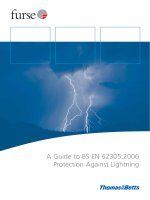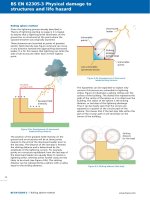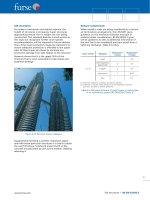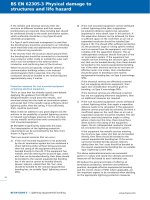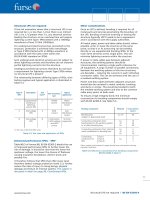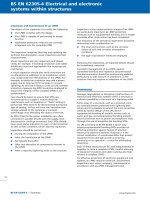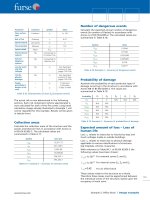Bsi bs en 00459 1 2015
Bạn đang xem bản rút gọn của tài liệu. Xem và tải ngay bản đầy đủ của tài liệu tại đây (1.24 MB, 56 trang )
BS EN 459-1:2015
BSI Standards Publication
Building lime
Part 1: Definitions, specifications and
conformity criteria
BS EN 459-1:2015
BRITISH STANDARD
National foreword
This British Standard is the UK implementation of EN 459-1:2015. It
supersedes BS EN 459-1:2010 which is withdrawn.
The UK participation in its preparation was entrusted to Technical
Committee B/516/11, Lime.
A list of organizations represented on this committee can be
obtained on request to its secretary.
This publication does not purport to include all the necessary
provisions of a contract. Users are responsible for its correct
application.
© The British Standards Institution 2015. Published by BSI Standards
Limited 2015
ISBN 978 0 580 87067 5
ICS 01.040.91; 91.100.10
Compliance with a British Standard cannot confer immunity from
legal obligations.
This British Standard was published under the authority of the
Standards Policy and Strategy Committee on 30 April 2015.
Amendments issued since publication
Date
Text affected
BS EN 459-1:2015
EN 459-1
EUROPEAN STANDARD
NORME EUROPÉENNE
EUROPÄISCHE NORM
April 2015
ICS 91.100.10
Supersedes EN 459-1:2010
English Version
Building lime - Part 1: Definitions, specifications and conformity
criteria
Chaux de construction - Partie 1 : Définitions, spécifications
et critères de conformité
Baukalk - Teil 1: Begriffe, Anforderungen und
Konformitätskriterien
This European Standard was approved by CEN on 16 February 2015.
CEN members are bound to comply with the CEN/CENELEC Internal Regulations which stipulate the conditions for giving this European
Standard the status of a national standard without any alteration. Up-to-date lists and bibliographical references concerning such national
standards may be obtained on application to the CEN-CENELEC Management Centre or to any CEN member.
This European Standard exists in three official versions (English, French, German). A version in any other language made by translation
under the responsibility of a CEN member into its own language and notified to the CEN-CENELEC Management Centre has the same
status as the official versions.
CEN members are the national standards bodies of Austria, Belgium, Bulgaria, Croatia, Cyprus, Czech Republic, Denmark, Estonia,
Finland, Former Yugoslav Republic of Macedonia, France, Germany, Greece, Hungary, Iceland, Ireland, Italy, Latvia, Lithuania,
Luxembourg, Malta, Netherlands, Norway, Poland, Portugal, Romania, Slovakia, Slovenia, Spain, Sweden, Switzerland, Turkey and United
Kingdom.
EUROPEAN COMMITTEE FOR STANDARDIZATION
COMITÉ EUROPÉEN DE NORMALISATION
EUROPÄISCHES KOMITEE FÜR NORMUNG
CEN-CENELEC Management Centre: Avenue Marnix 17, B-1000 Brussels
© 2015 CEN
All rights of exploitation in any form and by any means reserved
worldwide for CEN national Members.
Ref. No. EN 459-1:2015 E
BS EN 459-1:2015
EN 459-1:2015 (E)
Contents
Page
Foreword ..............................................................................................................................................................3
Introduction .........................................................................................................................................................4
1
Scope ......................................................................................................................................................5
2
Normative references ............................................................................................................................5
3
Terms and definitions ...........................................................................................................................5
4
4.1
4.2
4.3
4.4
4.5
Air lime ....................................................................................................................................................6
General ....................................................................................................................................................6
Sub-families of air lime .........................................................................................................................7
Forms of air lime ....................................................................................................................................7
Calcium lime ...........................................................................................................................................7
Dolomitic lime ..................................................................................................................................... 13
5
5.1
5.2
5.3
5.4
5.5
5.6
Lime with hydraulic properties .......................................................................................................... 18
General ................................................................................................................................................. 18
Sub-families of lime with hydraulic properties ................................................................................ 18
Natural hydraulic lime ........................................................................................................................ 19
Formulated lime .................................................................................................................................. 20
Hydraulic lime ..................................................................................................................................... 23
Assessment and verification of constancy of performance of natural hydraulic lime,
formulated lime and hydraulic lime .................................................................................................. 25
Standard designation of lime with hydraulic properties ................................................................ 28
5.7
Annex A (normative) Statistical evaluation methods for strength, physical and chemical
properties ............................................................................................................................................ 29
A.1
Statistical conformity criteria ............................................................................................................ 29
A.2
Single result conformity criteria........................................................................................................ 31
Annex B (informative) Additional properties for building lime .................................................................. 36
Annex C (informative) Schematic diagram for the types of lime and fields of application .................... 38
Annex D (normative) Declaration of composition for formulated lime ..................................................... 39
D.1
Main constituents content to be declared by the producer ........................................................... 39
D.2
Minor constituents .............................................................................................................................. 39
D.3
Additives .............................................................................................................................................. 39
D.4
Declaration of composition ............................................................................................................... 39
D.5
Standard designation ......................................................................................................................... 40
Annex ZA (informative) Clauses of this European Standard addressing the provisions of the
EU Construction Product Regulation ............................................................................................... 41
Bibliography ..................................................................................................................................................... 51
2
BS EN 459-1:2015
EN 459-1:2015 (E)
Foreword
This document (EN 459-1:2015) has been prepared by Technical Committee CEN/TC 51 “Cement and
building limes”, the secretariat of which is held by NBN.
This European Standard shall be given the status of a national standard, either by publication of an identical
text or by endorsement, at the latest by October 2015, and conflicting national standards shall be withdrawn at
the latest by January 2017.
Attention is drawn to the possibility that some of the elements of this document may be the subject of patent
rights. CEN [and/or CENELEC] shall not be held responsible for identifying any or all such patent rights.
This document supersedes EN 459-1:2010.
This document has been prepared under a mandate given to CEN by the European Commission and the
European Free Trade Association.
For relationship with Regulation (EU) No. 305/2011, see informative Annex ZA, which is an integral part of this
document.
EN 459, Building lime, consists of the following parts:
—
Part 1: Definitions, specifications and conformity criteria;
—
Part 2: Test methods;
—
Part 3: Conformity evaluation.
The requirements in EN 459-1 are based on the results of tests on building lime determined in accordance
with EN 459-2.
Annexes A and D are normative, Annexes B, C and ZA are informative.
According to the CEN-CENELEC Internal Regulations, the national standards organizations of the following
countries are bound to implement this European Standard: Austria, Belgium, Bulgaria, Croatia, Cyprus, Czech
Republic, Denmark, Estonia, Finland, Former Yugoslav Republic of Macedonia, France, Germany, Greece,
Hungary, Iceland, Ireland, Italy, Latvia, Lithuania, Luxembourg, Malta, Netherlands, Norway, Poland, Portugal,
Romania, Slovakia, Slovenia, Spain, Sweden, Switzerland, Turkey and the United Kingdom.
3
BS EN 459-1:2015
EN 459-1:2015 (E)
Introduction
The revision of this European Standard for building lime was initiated by Decision 4 taken by CEN/TC 51
“Cement and building limes” in 2013.
Different sources of raw materials and different climatic conditions have led to different developments in
building construction and civil engineering practices and materials and therefore to different kinds of building
lime in different regions of Europe.
The inclusion of a wider range of building lime which exists in Europe has made it necessary to establish a
number of classes.
The previous national standards for building lime generally also formed the basis for different areas of
application (see Annex C (informative)). The classification chosen therefore also takes into consideration
these circumstances as far as possible.
For a better understanding, the standard makes a clear distinction between air lime (Clause 4) and lime with
hydraulic properties (Clause 5). Depending on the composition and characteristics of the products, each
clause is then divided into sub-paragraphs (calcium lime and dolomitic lime for air lime; natural hydraulic lime,
formulated lime and hydraulic lime for lime with hydraulic properties) containing the appropriate definitions,
specifications and conformity criteria.
4
BS EN 459-1:2015
EN 459-1:2015 (E)
1
Scope
This European Standard applies to building lime used for:
—
preparation of binder for mortar (for example for masonry, rendering and plastering);
—
production of other construction products (for example calcium silicate bricks, autoclaved aerated
concrete, concrete, etc.);
—
civil engineering applications (for example soil treatment, asphalt mixtures, etc.).
It gives definitions for the different types of building lime and their classification. It also gives requirements for
their chemical and physical properties which depend on the type of building lime and specifies the conformity
criteria.
Terms of delivery or other contractual conditions, normally included in documents exchanged between the
supplier and the purchaser of building lime, are outside the scope of this European Standard.
2
Normative references
The following documents, in whole or in part, are normatively referenced in this document and are
indispensable for its application. For dated references, only the edition cited applies. For undated references,
the latest edition of the referenced document (including any amendments) applies.
EN 197-1, Cement — Part 1: Composition, specifications and conformity criteria for common cements
EN 459-2:2010, Building lime — Part 2: Test methods
EN 459-3:2015, Building lime — Part 3: Conformity evaluation
3
Terms and definitions
For the purposes of this document, the following terms, definitions and abbreviations apply.
NOTE
See also Annex C.
3.1
lime
calcium oxide and/or hydroxide, and calcium-magnesium oxide and/or hydroxide produced by the thermal
decomposition (calcination) of naturally occurring calcium carbonate (for example limestone, chalk, shells) or
naturally occurring calcium magnesium carbonate (for example dolomitic limestone, dolomite)
3.2
building lime
group of lime products, exclusively consisting of two families: air lime and lime with hydraulic properties, used
in applications or materials for construction, building and civil engineering
3.3
air lime 1)
lime (see 3.1) which combines and hardens with carbon dioxide present in air
Note 1 to entry:
Air lime has no hydraulic properties. Air lime is divided into two sub-families, calcium lime (CL) and
dolomitic lime (DL).
1)
Translation of a term used in most European countries.
5
BS EN 459-1:2015
EN 459-1:2015 (E)
3.4
lime with hydraulic properties
building lime (see 3.2) consisting mainly of calcium hydroxide, calcium silicates and calcium aluminates
Note 1 to entry:
It has the property of setting and hardening when mixed with water and/or under water. Reaction with
atmospheric carbon dioxide is part of the hardening process. Lime with hydraulic properties is divided into three subfamilies, natural hydraulic lime (NHL), formulated lime (FL) and hydraulic lime (HL).
3.5
allowable probability of acceptance
CR
for a given sampling plan, allowed probability of acceptance of building lime with a characteristic value outside
the specified characteristic value
3.6
sampling plan
specific plan which states the (statistical) sample size(s) to be used, the percentile Pk and the allowable
probability of acceptance CR
3.7
characteristic value
value of a required property outside which lies a specified percentage, the percentile Pk, of all the values of
the population
3.8
specified characteristic value
characteristic value of a strength, physical or chemical property which in the case of an upper limit is not to be
exceeded or in the case of a lower limit is, as a minimum, to be reached
3.9
single result limit value
value of a strength, physical or chemical property which − for any single test result − in the case of an upper
limit is not be exceeded or in the case of a lower limit is, as a minimum, to be reached
3.10
spot sample
sample taken at the same time and from one and the same place, relating to the intended tests
Note 1 to entry:
It can be obtained by combining one or more immediately consecutive increments (see EN 459–2).
3.11
autocontrol testing
continual testing by the manufacturer of building lime spot samples taken at the point(s) of release from the
factory/depot
3.12
control period
period of production and dispatch identified for the evaluation of the autocontrol test results
4
4.1
Air lime
General
Air lime is used for the preparation or the production of materials used in building construction as well as in
civil engineering.
6
BS EN 459-1:2015
EN 459-1:2015 (E)
Air lime (see 3.3) when appropriately batched and mixed with water, forms a paste that improves the
workability (values of flow and penetration) and water retention of mortars. The carbonation of hydrates in
contact with atmospheric carbon dioxide forms calcium carbonate which develops strength and contributes to
the durability of mortars containing building lime (hence the name of air lime).
Sub-families and forms of air lime are given in 4.2 and 4.3 respectively.
4.2
Sub-families of air lime
4.2.1
Calcium lime (CL)
Calcium lime is an air lime consisting mainly of calcium oxide and/or calcium hydroxide without any hydraulic
or pozzolanic addition.
4.2.2
Dolomitic lime (DL)
Dolomitic lime is an air lime consisting mainly of calcium magnesium oxide and/or calcium magnesium
hydroxide without any hydraulic or pozzolanic addition.
4.3
Forms of air lime
4.3.1
Quicklime (Q)
Quicklime is an air lime mainly in the oxide form which reacts exothermically on contact with water. Quicklime
is available in a range of sizes from lump to powder.
4.3.2
Hydrated lime (S, S PL or S ML)
Hydrated lime is an air lime mainly in the hydroxide form produced by the controlled slaking of quicklime.
Hydrated lime is available as:
—
powder (S);
—
putty (S PL); or
—
slurry or milk of lime (S ML).
Dolomitic lime is also produced as semi-hydrated dolomitic lime (S1), mainly consisting of calcium hydroxide
and magnesium oxide.
4.4
4.4.1
Calcium lime
Classification of calcium lime
Calcium lime shall be classified according to the notation given in Table 1 and its total (CaO + MgO) content in
accordance with Table 2.
7
BS EN 459-1:2015
EN 459-1:2015 (E)
Table 1 — Types of calcium lime a
Designation
Notation
Calcium lime 90
CL 90
Calcium lime 80
CL 80
Calcium lime 70
CL 70
a In addition, calcium lime is classified according to the form of the product, quicklime (Q), hydrated lime (S), lime
putty (S PL) or milk of lime (S ML).
Conformity with this classification is assessed by means of statistical quality control as described in Annex A
of this European Standard.
4.4.2
Chemical requirements for calcium lime
The properties of the type of calcium lime shown in Table 2 determined in accordance with EN 459-2 shall
conform to the requirements in that table. All types of calcium lime listed in Table 2 may contain additives in
small quantities to improve the manufacture or properties of calcium lime. When the total content exceeds
0,1 %, the actual types and amounts shall be declared.
Table 2 — Chemical requirements of calcium lime given as characteristic values
Values given as mass fraction in percent
Type of calcium lime
CaO + MgO
MgOa
CO2b
SO3
Available
limec
CL 90
≥ 90
≤5
≤4
≤2
≥ 80
CL 80
≥ 80
≤5
≤7
≤2
≥ 65
CL 70
≥ 70
≤5
≤ 12
≤2
≥ 55
The values for CaO + MgO, MgO, CO2 and SO3 are applicable to all forms of calcium lime. For quicklime
these values correspond to the finished product; for all other forms of lime (hydrated lime, lime putty and milk
of lime) the values are based on the product after subtraction of its free water and bound water content.
The values for available lime (calcium oxide for quicklime, calcium hydroxide for hydrated lime) refer to the
product when tested in accordance with EN 459–2.
a
MgO content up to 7 % is permitted if the soundness test in accordance with EN 459–2 is passed.
b
A higher content of CO2 is permitted, if all other chemical requirements in Table 2 are satisfied and the test
frequency satisfies the requirements in Table 7.
c Higher values of available lime may be requested.
4.4.3
Physical requirements and other physical properties for quicklime
The physical properties of the type of quicklime shown in Table 3 and Table 4 determined in accordance with
EN 459-2 shall conform to the requirements in those tables.
8
BS EN 459-1:2015
EN 459-1:2015 (E)
Table 3 — Physical requirements of quicklime
Soundness after slaking in accordance with
EN 459–2:2010, 6.4.4a
Type of quicklime
CL 90
CL 80
Pass
CL 70
a
Slaking according to the instructions of the lime producer.
Table 4 — Reactivity (R) of quicklime given as characteristic values
Type of
quicklime
Reactivity (time in min), in accordance with EN 459–2:2010, 6.6
R5
R4
CL 90
t60 < 10
t60 < 25
CL 80
t60 < 10
t60 < 25
CL 70
—
—
R3
R2
—
—
t50 < 25
—
—
t40 < 25
Rsv
other specified
value or no
requirement
The particle size distribution of all types of quicklime shown in Table 1 shall conform to the requirements in
Table 5 and shall be determined in accordance with EN 459-2.
Table 5 — Particle size distribution (P) of quicklime given as characteristic values
Sieve size
Particle size distributiona (mass fraction passing the sieve in percent),
in accordance with EN 459–2:2010, Clause 6
P4
P3
P2
P1
10 mm
100
—
—
—
5 mm
≥ 95
100
100
—
2 mm
—
≥ 95
≥ 95
100
0,2 mm
—
—
≥ 70
≥ 95
0,09 mm
—
≥ 30
≥ 50
≥ 85
Psv
other specified
value or no
requirement
a Particle size ≥ 2 mm shall be determined by dry sieving in accordance with EN 459–2:2010, 6.1 and particle
size < 2 mm by air-jet sieving in accordance with EN 459–2:2010, 6.2.
4.4.4
Physical requirements and other physical properties for hydrated lime and lime putty
The physical properties of hydrated lime and lime putty of the type shown in Table 6 determined in
accordance with EN 459-2 shall conform to the requirements in that table.
9
BS EN 459-1:2015
EN 459-1:2015 (E)
a
Table 6 — Physical requirements of hydrated calcium lime and lime putty , given as characteristic
values
Type of
hydrated
calcium
lime
Particle sizeb
% residue by mass
Free
water
contentc
Soundnessd, e
Mortar testsb, f
For hydrated limes
Reference
method
Alternative
method
0,09 mmg
0,2 mm
%
mm
mm
≤7
≤2
≤2
≤2
≤ 20
Lime
putty
CL 90
CL 80
Pass
CL 70
Penetration
Air
content
mm
%
> 10
and < 50
≤ 12
a Particle size and free water content apply to hydrated calcium lime for all applications. Soundness, penetration and air
content apply only to hydrated calcium lime for masonry mortar, plastering and rendering.
b Not for lime putty.
c
Not for lime putty. The free water content of lime putty is normally between 45 % and 70 %.
d
Tested in accordance with EN 459–2:2010, 6.4.
e Hydrated calcium lime which includes particles larger than 0,2 mm shall satisfy the requirements of the soundness
test for hydrated calcium limes with grains larger than 0,2 mm in EN 459–2.
f
Tested in accordance with the test on standard mortar in EN 459–2.
g A residue on 0,09 mm sieve up to 15 % is permitted as long as the soundness test given in EN 459–2:2010, 6.4.2 is
passed.
4.4.5
Additional properties
Other properties may be subject either to requirements in application standards dealing with the use of
calcium lime or to requests from the user. These properties are given in informative Annex B.
4.4.6
Durability requirements
The choice of calcium lime, particularly as regards types for different applications and exposure conditions
shall follow the appropriate European or national application standards and/or regulations valid in the place of
use.
4.4.7
Dangerous substances
National regulations on dangerous substances may require verification and declaration on release, and
sometimes content, when construction products covered by this standard are placed on those markets.
In the absence of European harmonized test methods, verification and declaration on release/content should
be done taking into account national provisions in the place of use.
NOTE
An informative database covering European and national provisions on dangerous substances is available at
the Construction website on EUROPA accessed through: />
10
BS EN 459-1:2015
EN 459-1:2015 (E)
4.4.8
Assessment and verification of constancy of performance of calcium lime
4.4.8.1
General requirements
Conformity of calcium lime to this European Standard shall be continuously evaluated on the basis of testing
of spot samples. The properties to be tested for the autocontrol testing by the manufacturer, test methods and
the minimum testing frequencies for each type of calcium lime detailed in Table 1 are specified in Table 7.
The declaration of performance by the manufacturer, shall be based on the assessment and verification of
constancy of performance of building lime with this European Standard according to the scheme specified in
EN 459-3.
Requirements for the declaration of performance which the manufacturer should make available under the CE
marking procedure are established in Annex ZA.
4.4.8.2
Conformity requirements
Sampling shall take place at the point of release of the building lime.
Conformity of calcium lime with the requirements concerning chemical and physical properties in this
European Standard is assumed if the requirements in Tables 2 to 6 inclusive are met. The requirements in
these tables shall be taken as absolute values.
The evaluation procedure depends on the frequency of testing during the control period of 12 months. If the
number of samples is at least one per week, the evaluation may be statistical (characteristic values)
(see Annex A).
Statistical evaluation is normally carried out by attributes (see Table 7 and A.1.3). If the data are normally
distributed, the evaluation may be made by variables (see Table 7 and A.1.2).
NOTE
This standard does not deal with acceptance inspection at delivery.
Table 7 — Properties, test methods and minimum testing frequencies a for the autocontrol testing by
the manufacturer
Minimum frequency of testing by manufacturer
Property
Form of calcium
limeb
Test method
to be usedc
1
2
3
Particle size
Soundness
Autocontrol testing
Regulard
(see
4.4.8.2)
Product type
determinationl
Inspection by
variablesh
Inspection by
attributesj
4
5
6
7
1/week
2/week
X
Hydrated limem
1/day
2/day
X
Quicklimee
Hydrated lime
1/dayg
2/day
X
1/week
2/week
X
Quicklime
Lime putty
EN 459–2
Penetration/
Water demand
Hydrated lime
2/year
1/month
X
Air content
Hydrated limek
2/year
1/month
X
CaO + MgO, MgOf
Quicklime
Hydrated lime
Lime putty
1/week
2/week
X
11
BS EN 459-1:2015
EN 459-1:2015 (E)
Minimum frequency of testing by manufacturer
Property
Form of calcium
limeb
Test method
to be usedc
1
2
3
Autocontrol testing
Regulard
(see
4.4.8.2)
Product type
determinationl
Inspection by
variablesh
Inspection by
attributesj
4
5
6
7
CO2f, n
Quicklime
Hydrated lime
Lime putty
1/week
2/week
X
SO3
Quicklime
Hydrated lime
Lime putty
1/month
2/month
X
Available limef, o
Quicklime
Hydrated lime
Lime putty
1/week
2/week
X
Free water
Hydrated lime
Lime putty
1/month
2/month
X
Reactivity
Quicklime
1/week
2/week
X
a The methods used to take and prepare samples shall be in accordance with EN 459–2. Tests may be carried out at
any time between production and dispatch. The producer shall ensure that the requirements are met at the time of
dispatch.
b See 4.3 and Table 1.
c Any other methods may be used provided they are calibrated, either against the reference methods or against
internationally accepted reference materials, in order to demonstrate their equivalence.
d The control period for conformity evaluation is 12 months.
e
a
After slaking (see Table 3, Footnote ).
f
If the test frequency of CaO + MgO and CO2 is higher than the required frequency (e.g. CaO + MgO > 1/week and
CO2 > 1/week) then the test frequency of available lime may be reduced to twice per year.
If the test frequency of available lime and CO2 is higher than the required frequency (e.g. available lime > 1/week
and CO2 > 1/week) then the test frequency of CaO + MgO may be reduced to twice per year.
g For hydrated lime: If 30 consecutive test results are less than 10 % of the required value then the test frequency may
be reduced to once per month. If any single result is higher than 10 % of the required value then return to daily testing.
For quicklime: If 30 consecutive test results meet the requirement, then the test frequency may be reduced to once
per month. If any single result fails the requirement, then return to daily testing.
h If the data are not normally distributed the evaluation shall be made by attributes.
j
If the number of samples taken during the control period is at least one per week the evaluation may be made by
variables.
k For lime without additives this test is required only for product type determination.
l
See EN 459–3:2015, 4.4.
m
See Table 6, Footnote .
n
See Table 2, Footnote .
o
See Table 2, Footnote .
g
b
4.4.9
c
Standard designation of calcium lime
Calcium lime shall be identified by its notation specified in Table 1, by the form of the product given in 4.3 and
for quicklime by the physical requirements given in 4.4.3 (see examples below).
12
BS EN 459-1:2015
EN 459-1:2015 (E)
EXAMPLE 1
Calcium lime 90 in the form of quicklime, reactivity R5 and particle size distribution P1, is identified by:
EN 459–1 CL 90-Q (R5, P1)
EXAMPLE 2
Calcium lime 80 in the form of quicklime, reactivity Rsv (other specified value or no requirement) and
particle size distribution P4, is identified by:
EN 459–1 CL 80-Q (Rsv, P4)
EXAMPLE 3
Calcium lime 80 in the form of hydrated lime is identified by:
EN 459–1 CL 80-S
EXAMPLE 4
Calcium lime 90 in the form of lime putty is identified by:
EN 459–1 CL 90-S PL
EXAMPLE 5
Calcium lime 90 in the form of milk of lime is identified by:
EN 459–1 CL 90-S ML
4.5
4.5.1
Dolomitic lime
Classification of dolomitic lime
Dolomitic lime shall be classified according to the notation given in Table 8 and its total (CaO + MgO) content
in accordance with Table 9.
Table 8 — Types of dolomitic lime a
Designation
Notation
Dolomitic lime 90–30
DL 90–30
Dolomitic lime 90–5
DL 90–5
Dolomitic lime 85–30
DL 85–30
Dolomitic lime 80–5
DL 80–5
a In addition, dolomitic lime is classified according to the form of the product, quicklime (Q) or hydrated lime (S). Semi
hydrated dolomitic lime is classified as (S1).
Conformity with this classification is assessed by means of statistical quality control as described in Annex A
of this European Standard.
4.5.2
Chemical requirements for dolomitic lime
The properties of the type of dolomitic lime shown in Table 9 determined in accordance with EN 459-2 shall
conform to the requirements in that table. All types of dolomitic lime listed in Table 9 may contain additives in
small quantities to improve the manufacture or properties of dolomitic lime. When the total content exceeds
0,1 %, the actual types and amounts shall be declared.
13
BS EN 459-1:2015
EN 459-1:2015 (E)
Table 9 — Chemical requirements of dolomitic lime given as characteristic values
Values given as mass fraction in percent
Type of dolomitic
lime
CaO + MgO
DL 90–30
MgO
CO2
SO3
≥ 90
≥ 30
≤6
≤2
DL 90–5
≥ 90
>5
≤6
≤2
DL 85–30
≥ 85
≥ 30
≤9
≤2
DL 80–5
≥ 80
>5
≤9
≤2
NOTE
The values are applicable to all kinds of dolomitic lime. For dolomitic quicklime these values
correspond to the finished product; for hydrated dolomitic lime the values are based on the product after
subtraction of its free water and bound water content.
4.5.3
Physical requirements and other physical properties for dolomitic quicklime
The physical properties of dolomitic quicklime of the type shown in Tables 10 and 11 determined in
accordance with EN 459-2 shall conform to the requirements in those Tables.
Table 10 — Physical requirements of dolomitic quicklime
Soundness after slaking in accordance with
EN 459–2:2010, 6.4.4a
Type of dolomitic quicklime
DL 90–30
DL 90–5
Pass
DL 85–30
DL 80–5
a
Slaking according to the instructions of the lime producer.
Table 11 — Reactivity of dolomitic quicklime given as characteristic values
Reactivity (time in minutes), in accordance with EN 459–2:2010, 6.6
Type of dolomitic
quicklime
R5
DL 90–30
DL 90–5
—
t60 < 10
DL 85–30
—
DL 80–5
—
R2
R1
t40 < 25
—
t40 < 25
—
t40 < 25
—
—
Rsv
other specified value
or no requirement
t35 < 25
The particle size distribution of all types of dolomitic quicklime shown in Table 8 shall conform to the
requirements in Table 12 and shall be determined in accordance with EN 459-2.
14
BS EN 459-1:2015
EN 459-1:2015 (E)
Table 12 — Particle size distribution of dolomitic quicklime given as characteristic values
Sieves
Particle size distributiona (mass fraction passing the sieve in percent),
in accordance with EN 459–2:2010, Clause 6
P4
P3
P2
P1
10 mm
100
—
—
—
5 mm
≥ 95
100
100
—
2 mm
—
≥ 95
≥ 95
100
0,2 mm
—
—
≥ 70
≥ 95
0,09 mm
—
≥ 30
≥ 50
≥ 85
Psv
other specified
value or no
requirement
a Particle size ≥ 2 mm shall be determined by dry sieving in accordance with EN 459–2:2010, 6.1 and particle
size < 2 mm by air-jet sieving in accordance with EN 459–2:2010, 6.2.
4.5.4
Physical requirements and other physical properties for dolomitic hydrated lime
The physical properties of dolomitic hydrated lime of the type shown in Table 13 determined in accordance
with EN 459-2 shall conform to the requirements in that table.
Table 13 — Physical requirements of dolomitic hydrated lime a given as characteristic values
Particle size
Type of dolomitic
hydrated lime
% residue by mass
Free water
content
0,09 mm
0,2 mm
%
≤7
≤2
≤2
Mortar testsd
Soundnessb, c
Penetration
Air
content
mm
%
> 10
and < 50
≤ 12
DL 90–30
DL 90–5
DL 85–30
Pass
DL 80–5
a Particle size and free water content apply to dolomitic hydrated lime for all applications. Soundness, penetration and
air content apply only to dolomitic hydrated lime for masonry mortar, plastering and rendering.
b See EN 459–2:2010, 6.4.4.
c Dolomitic hydrated lime which includes particles larger than 0,2 mm shall satisfy the requirements of the soundness
test for dolomitic hydrated limes with grains larger than 0,2 mm in EN 459–2.
d Tested in accordance with the test on standard mortar in EN 459–2.
4.5.5
Additional properties
Other properties may be subject either to requirements in application standards dealing with the use of
dolomitic lime or to requests from the users. These properties are given in informative Annex B.
4.5.6
Durability requirements
The choice of dolomitic lime particularly as regards type for different applications and exposure conditions
shall follow the appropriate European or national application standards and/or regulations valid in the place of
use.
15
BS EN 459-1:2015
EN 459-1:2015 (E)
4.5.7
Dangerous substances
National regulations on dangerous substances may require verification and declaration on release, and
sometimes content, when construction products covered by this standard are placed on those markets.
In the absence of European harmonized test methods, verification and declaration on release/content should
be done taking into account national provisions in the place of use.
NOTE
An informative database covering European and national provisions on dangerous substances is available at
the Construction website on EUROPA accessed through: />
4.5.8
4.5.8.1
Assessment and verification of constancy of performance of dolomitic lime
General requirements
Conformity of dolomitic lime with this European Standard shall be continuously evaluated on the basis of
testing of spot samples. The properties to be tested for the autocontrol testing by the manufacturer, test
methods and the minimum testing frequencies for each type of dolomitic lime detailed in Table 8 are specified
in Table 14.
The declaration of performance by the manufacturer shall be based on the assessment and verification of
constancy of performance of building lime with this European Standard according to the scheme specified in
EN 459-3.
Requirements for the declaration of performance which the manufacturer should make available under the CE
marking procedure are established in Annex ZA.
4.5.8.2
Conformity requirements
Sampling shall take place at the point of release of the building lime.
Conformity of dolomitic lime with the requirements concerning chemical and physical properties in this
European Standard is assumed if the requirements in Tables 9 to 13 inclusive are met. The requirements in
these tables shall be taken as absolute values.
The evaluation procedure depends on the frequency of testing during the control period of 12 months. If the
number of samples is at least one per week, the evaluation may be statistical (characteristic values) (see
Annex A).
Statistical evaluation is normally carried out by attributes (see Table 14 and A.1.3). If the data are normally
distributed, the evaluation may be made by variables (see Table 14 and A.1.2).
NOTE
16
This standard does not deal with acceptance inspection at delivery.
BS EN 459-1:2015
EN 459-1:2015 (E)
Table 14 — Properties, test methods and minimum testing frequencies a for the autocontrol testing by
the manufacturer
Minimum frequency of testing by manufacturer
Property
Form of
dolomitic limeb
Test
method to
be usedc
1
2
3
Autocontrol testing
Regulard Product type
(see
determinationl
4.5.8.2)
Inspection
by
variablesh
Inspection
by attributesj
6
7
4
5
Quicklime and
1/week
2/week
X
Hydrated lime
1/day
2/day
X
Soundness
Quicklimee
Hydrated lime
1/dayg
2/day
X
Penetration/
Water demand
Hydrated lime
2/year
1/month
X
Air content
Hydrated limek
2/year
1/month
X
1/week
2/week
X
Particle size
EN 459–2
CaO + MgO, MgO
Quicklime
Hydrated lime
CO2
Quicklime
Hydrated lime
1/week
2/week
X
SO3
Quicklime
Hydrated lime
1/month
2/month
X
Free water
Hydrated lime
1/month
2/month
X
Reactivity
Quicklime
1/week
2/week
X
a The methods used to take and prepare samples shall be in accordance with EN 459–2. Tests may be carried out at
any time between production and dispatch. The producer shall ensure that the requirements are met at the time of
dispatch.
b See 4.3 and Table 8.
c Any other methods may be used provided they are calibrated, either against the reference methods or against
internationally accepted reference materials, in order to demonstrate their equivalence.
d The control period for conformity evaluation is 12 months.
e
a
After slaking (see Table 10, Footnote ).
g For hydrated lime: If 30 consecutive test results are less than 10 % of the required value then the test frequency
may be reduced to once per month. If any single result is higher than 10 % of the required value, then return to daily
testing.
For quicklime: If 30 consecutive test results meet the requirement, then the test frequency may be reduced to once
per month. If any single result fails the requirement, then return to daily testing.
h If the data are not normally distributed the evaluation shall be made by attributes.
j
If the number of samples taken during the control period is at least one per week the evaluation may be made by
variables.
k For lime without additives this test is required only for product type determination.
l
See EN 459–3:2015, 4.4.
17
BS EN 459-1:2015
EN 459-1:2015 (E)
4.5.9
Standard designation of dolomitic lime
Dolomitic lime shall be identified by its type and notation specified in Table 8, by the form of the product given
in 4.3 and for quicklime by the physical requirements given in 4.5.3 (see examples below).
EXAMPLE 1
identified by:
NOTE Dolomitic lime 90–30 in the form of quicklime, reactivity R2 and particle size distribution P2, is
EN 459–1 DL 90–30-Q (R2, P2)
EXAMPLE 2
Dolomitic lime 85–30 in the form of quicklime, reactivity Rsv (other specified value or no requirement) and
particle size distribution P4, is identified by:
EN 459–1 DL 85–30-Q (Rsv, P4)
EXAMPLE 3
Dolomitic lime 85–30 in the form of hydrated lime is identified by:
EN 459–1 DL 85–30-S
EXAMPLE 4
Dolomitic lime 85–30 in the form of semi hydrated lime is identified by:
EN 459–1 DL 85–30-S1
5
Lime with hydraulic properties
5.1
General
Lime with hydraulic properties (see 3.4), when appropriately batched and mixed with aggregate and water,
produces mortar or concrete which retains its workability for a sufficient time and after predetermined periods
achieves a specified strength and also long-term volume stability.
Lime with hydraulic properties has an initial set, is classified according to its mechanical compressive strength
and has a defined range of available lime content.
Lime with hydraulic properties has the property of setting and hardening when mixed with water and by
reaction with carbon dioxide from the air (carbonation).
5.2
5.2.1
Sub-families of lime with hydraulic properties
Natural hydraulic lime (NHL)
Natural hydraulic lime is a lime with hydraulic properties produced by burning of more or less argillaceous or
siliceous limestones (including chalk) with reduction to powder by slaking with or without grinding. It has the
property of setting and hardening when mixed with water and by reaction with carbon dioxide from the air
(carbonation).
The hydraulic properties exclusively result from the special chemical composition of the natural raw material.
Grinding agents up to 0,1 % are allowed. Natural hydraulic lime does not contain any other additions.
5.2.2
Formulated lime (FL)
Formulated lime is a lime with hydraulic properties mainly consisting of air lime (CL) and/or natural hydraulic
lime (NHL) with added hydraulic and/or pozzolanic material. It has the property of setting and hardening when
mixed with water and by reaction with carbon dioxide from the air (carbonation).
18
BS EN 459-1:2015
EN 459-1:2015 (E)
5.2.3
Hydraulic lime (HL)
Hydraulic lime is a binder consisting of lime and other materials such as cement, blast furnace slag, fly ash,
limestone filler and other suitable materials. It has the property of setting and hardening under water.
Atmospheric carbon dioxide contributes to the hardening process.
5.3
Natural hydraulic lime
5.3.1
Classification of natural hydraulic lime
Natural hydraulic lime shall be classified according to the notation given in Table 15 and its compressive
strength in accordance with Table 17.
Table 15 — Types of natural hydraulic limes
Designation
Notation
Natural hydraulic lime 2
NHL 2
Natural hydraulic lime 3,5
NHL 3,5
Natural hydraulic lime 5
NHL 5
Conformity with this classification is assessed by means of statistical quality control as described in Annex A
of this European Standard.
5.3.2
Chemical requirements for natural hydraulic lime
The chemical properties of natural hydraulic lime of the type shown in Table 16 determined in accordance with
EN 459-2 shall conform to the requirements in that table.
Table 16 — Chemical requirements of natural hydraulic lime given as characteristic values
Type of natural hydraulic lime
SO3
Available lime as Ca(OH)2
in accordance with EN 459–2:2010, 5.8
Values in mass fraction in percent
NOTE
5.3.3
5.3.3.1
NHL 2
≤2
≥ 35
NHL 3,5
≤2
≥ 25
NHL 5
≤2
≥ 15
The values for SO3 are based on the product after subtraction of its free water and bound water content.
Physical requirements and other physical properties for natural hydraulic lime
Standard strength requirements for natural hydraulic lime
The standard strengths of the types of natural hydraulic lime are the compressive strengths determined in
accordance with EN 459-2 and shall conform to the requirements in Table 17.
19
BS EN 459-1:2015
EN 459-1:2015 (E)
Table 17 — Compressive strength of natural hydraulic lime given as characteristic values
Compressive strength
MPa
Type of natural hydraulic lime
5.3.3.2
7d
28 d
NHL 2
—
≥ 2 to ≤ 7
NHL 3,5
—
≥ 3,5 to ≤ 10
NHL 5
≥2
≥ 5 to ≤ 15
Other physical properties of natural hydraulic lime
The physical properties of natural hydraulic lime of the type shown in Table 18 determined in accordance with
EN 459-2 shall conform to the requirements in that table.
Table 18 — Physical requirements of natural hydraulic lime a given as characteristic values
Particle size
Type of
natural
hydraulic
lime
% residue by
mass
0,09
mm
Free
water
content
0,2
mm
Soundnessb
Reference Alternative
Penetration
method
method
%
mm
mm
mm
≤ 20
> 10
and
< 50
NHL 2
NHL 3,5
≤ 15
≤2
Mortar testsc
≤2
≤2
NHL 5
Air
content
Setting times
initial
%
final
h
≤ 40
≤5
>1
≤ 30
≤ 15
a Particle size and free water content apply to natural hydraulic lime for all applications. Soundness, penetration,
air content and setting time apply only to natural hydraulic lime for masonry mortar, plastering and rendering.
b Tested in accordance with EN 459–2:2010, 6.4.
c
5.3.4
Tested in accordance with the test on standard mortar in EN 459–2.
Additional properties
Other properties may be subject either to requirements in application standards dealing with the use of natural
hydraulic lime or to requests from the user. These properties are given in informative Annex B.
5.3.5
Durability requirements
The choice of natural hydraulic lime, particularly as regards types for different applications and exposure
conditions shall follow the appropriate European or national application standards and/or regulations valid in
the place of use.
5.4
5.4.1
Formulated lime
Classification of formulated lime
Formulated lime shall be classified according to the notation given in Table 19, its available lime content in
accordance with Table 20, and its compressive strength in accordance with Table 21.
20
BS EN 459-1:2015
EN 459-1:2015 (E)
Table 19 — Types of formulated lime
Designation
Notation
Formulated lime A 2
FL A 2
Formulated lime A 3,5
FL A 3,5
Formulated lime A 5
FL A 5
Formulated lime B 2
FL B 2
Formulated lime B 3,5
FL B 3,5
Formulated lime B 5
FL B 5
Formulated lime C 2
FL C 2
Formulated lime C 3,5
FL C 3,5
Formulated lime C 5
FL C 5
Conformity with this classification is assessed by means of statistical quality control as described in Annex A
of this European Standard.
5.4.2
Composition of formulated lime
5.4.2.1
General
The composition of the formulated lime shall be declared by the producer in accordance with Annex D.
5.4.2.2
Constituents for formulated lime
5.4.2.2.1
General
The presence of clinker and/or cement in formulated lime shall be declared by the producer (see examples in
Annex D).
5.4.2.2.2
Main constituents of formulated lime
The main constituents to be used in formulated lime shall be those identified in Annex D.
5.4.2.2.3
Minor additional constituents of formulated lime and additives
The minor additional constituents and additives to be used in formulated lime shall be those identified in
Annex D.
5.4.3
Chemical requirements for formulated lime
The chemical properties of formulated lime of the type shown in Table 20 determined in accordance with
EN 459-2 shall conform to the requirements in that table.
21
BS EN 459-1:2015
EN 459-1:2015 (E)
Table 20 — Chemical requirements of formulated lime given as characteristic values
Type of formulated lime
Available lime as Ca(OH)2
in accordance with EN 459–2:2010, 5.8
SO3
Values in mass fraction in percent
NOTE
5.4.4
FL A
≤2
≥ 40 to < 80
FL B
≤2
≥ 25 to < 50
FL C
≤2
≥ 15 to < 40
The values for SO3 are based on the product after subtraction of its free water and bound water content.
Physical requirements and other physical properties for formulated lime
5.4.4.1
Standard strength requirements for formulated lime
The standard strengths of the types of formulated lime are the compressive strengths determined in
accordance with EN 459-2 and shall conform to the requirements in Table 21.
Table 21 — Compressive strength of formulated lime given as characteristic values
Compressive strength
MPa
Type of formulated lime
5.4.4.2
7d
28 d
All types of FL 2
—
≥ 2 to ≤ 7
All types of FL 3,5
—
≥ 3,5 to ≤ 10
All types of FL 5
≥2
≥ 5 to ≤ 15
Other physical properties of formulated lime
The physical properties of formulated lime of the type shown in Table 22 determined in accordance with
EN 459-2 shall conform to the requirements in that table.
22
BS EN 459-1:2015
EN 459-1:2015 (E)
Table 22 — Physical requirements of formulated lime a given as characteristic values
Particle size
Type of
formulated
lime
% residue by
mass
0,09
mm
Soundnessb
Free
water Reference Alternative
content
method
method
0,2
mm
%
mm
Penetration
Air
content
mm
mm
%
≤ 20
> 10
and < 50
FL 2
FL 3,5
≤ 15
≤5
≤2
≤2
Mortar testsc
FL 5
Setting times
initial
final
h
≤ 40
≤ 25
>1
≤ 30
≤ 15
a Particle size and free water content apply to formulated lime for all applications. Soundness, penetration, air
content and setting time apply only to formulated lime for masonry mortar, plastering and rendering.
b Tested in accordance with EN 459–2:2010, 6.4.
c
5.4.5
Tested in accordance with the test on standard mortar in EN 459–2.
Additional properties
Other properties may be subject either to requirements in application standards dealing with the use of
formulated lime or to requests from the user. These properties are given in informative Annex B.
5.4.6
Durability requirements
The choice of formulated lime, particularly as regards type and strength class for different applications and
exposure classes shall follow the appropriate European or national standards and/or regulations for mortar
and other construction products valid in the place of use.
5.5
5.5.1
Hydraulic lime
Classification of hydraulic lime
Hydraulic lime shall be classified according to the notation given in Table 23 and its compressive strength in
accordance with Table 25.
Table 23 — Types of hydraulic lime
Designation
Notation
Hydraulic lime 2
HL 2
Hydraulic lime 3,5
HL 3,5
Hydraulic lime 5
HL 5
Conformity with this classification is assessed by means of statistical quality control as described in Annex A
of this European Standard.
5.5.2
Chemical requirements for hydraulic lime
The chemical properties of hydraulic lime of the type shown in Table 24 determined in accordance with
EN 459-2 shall conform to the requirements in that table. All types of hydraulic lime listed in Table 24 may
23

